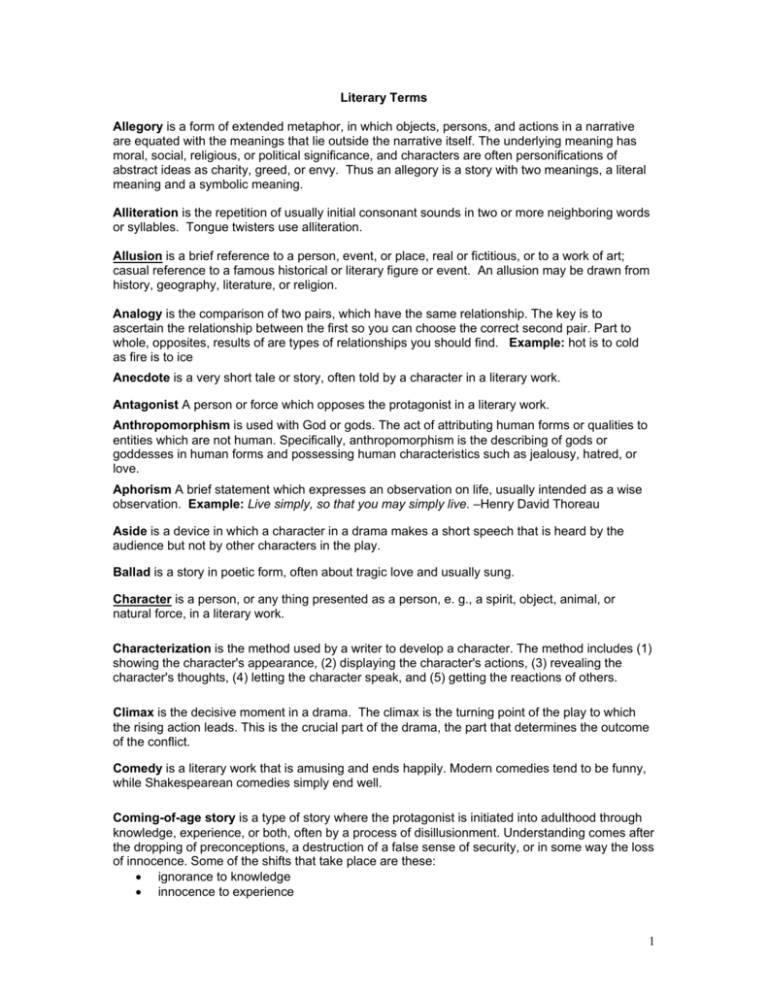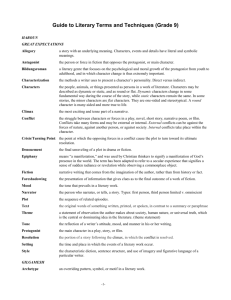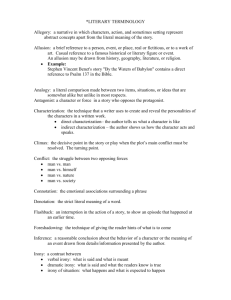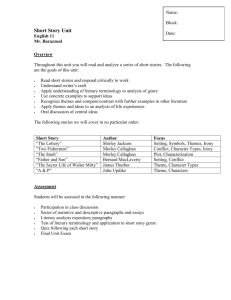Literary Terms
advertisement

Literary Terms Allegory is a form of extended metaphor, in which objects, persons, and actions in a narrative are equated with the meanings that lie outside the narrative itself. The underlying meaning has moral, social, religious, or political significance, and characters are often personifications of abstract ideas as charity, greed, or envy. Thus an allegory is a story with two meanings, a literal meaning and a symbolic meaning. Alliteration is the repetition of usually initial consonant sounds in two or more neighboring words or syllables. Tongue twisters use alliteration. Allusion is a brief reference to a person, event, or place, real or fictitious, or to a work of art; casual reference to a famous historical or literary figure or event. An allusion may be drawn from history, geography, literature, or religion. Analogy is the comparison of two pairs, which have the same relationship. The key is to ascertain the relationship between the first so you can choose the correct second pair. Part to whole, opposites, results of are types of relationships you should find. Example: hot is to cold as fire is to ice Anecdote is a very short tale or story, often told by a character in a literary work. Antagonist A person or force which opposes the protagonist in a literary work. Anthropomorphism is used with God or gods. The act of attributing human forms or qualities to entities which are not human. Specifically, anthropomorphism is the describing of gods or goddesses in human forms and possessing human characteristics such as jealousy, hatred, or love. Aphorism A brief statement which expresses an observation on life, usually intended as a wise observation. Example: Live simply, so that you may simply live. –Henry David Thoreau Aside is a device in which a character in a drama makes a short speech that is heard by the audience but not by other characters in the play. Ballad is a story in poetic form, often about tragic love and usually sung. Character is a person, or any thing presented as a person, e. g., a spirit, object, animal, or natural force, in a literary work. Characterization is the method used by a writer to develop a character. The method includes (1) showing the character's appearance, (2) displaying the character's actions, (3) revealing the character's thoughts, (4) letting the character speak, and (5) getting the reactions of others. Climax is the decisive moment in a drama. The climax is the turning point of the play to which the rising action leads. This is the crucial part of the drama, the part that determines the outcome of the conflict. Comedy is a literary work that is amusing and ends happily. Modern comedies tend to be funny, while Shakespearean comedies simply end well. Coming-of-age story is a type of story where the protagonist is initiated into adulthood through knowledge, experience, or both, often by a process of disillusionment. Understanding comes after the dropping of preconceptions, a destruction of a false sense of security, or in some way the loss of innocence. Some of the shifts that take place are these: • ignorance to knowledge • innocence to experience 1 • • • false view of world to correct view idealism to realism immature responses to mature responses Conflict is the struggle found in fiction. There are the basic forms (1 & 2 are external, 3 is internal): (1) Character(s) vs. Character(s)—this includes any other personified entity in the story (2) Character(s) vs. Nature—this includes the supernatural or anything wild or out of control (3) Character vs. itself Context- (1) the parts of a discourse that surround a word or passage and can throw light on its meaning (2) the interrelated conditions in which something exists or occurs Dialogue is the conversation between characters. Diction is an author's choice of words. Since words have specific meanings, and since one's choice of words can affect feelings, a writer's choice of words can have great impact in a literary work. Epic—a) a lengthy narrative poem in elevated language celebrating the adventures and achievements of a legendary or traditional hero; b) adj. Relating to or being an epic; very large or heroic Epistolary novel- A novel consisting of letters written by a character or several characters. The form allows for the use of multiple points of view toward the story and the ability to dispense with an omniscient narrator. Example: Frankenstein, by Mary Shelley Epithet is a word of phrase preceding or following a name, which serves to describe the character. Example: fair-skinned Juliet; all-knowing Caesar Euphemism- The substitution of a mild or less negative word or phrase for a harsh or blunt one, as in the use of "pass away" instead of "die." The basic psychology of euphemistic language is the desire to put something bad or embarrassing in a positive (or at least neutral light). Thus many terms referring to death, sex, crime, and excremental functions are euphemisms. Since the euphemism is often chosen to disguise something horrifying, it can be exploited through the use of irony and exaggeration. Fable- a myth, legend, or story, usually with animals as characters, that teaches a moral lesson. Flashback is a literary device that allows the writer to present events that happened before the time of the current narration or the current events in the fiction. Flashback techniques include memories, dreams, stories of the past told by characters, or even authorial sovereignty. That is, the author might simply say, "But back in Tom's youth. . . ." Flashback is useful for exposition, to fill in the reader about a character or place, or about the background to a conflict. Foot—the basic unit of meter consisting of a group of two or three syllables. Foreshadowing is the use of hints or clues to suggest what will happen later in a story. Frame- a narrative structure that provides a setting and exposition for the main narrative in a novel. Often, a narrator will describe where he found the manuscript of the novel or where he heard someone tell the story he is about to relate. The frame helps control the reader's perception of the work, and has been used in the past to help give credibility to the main section of the novel. Examples of novels with frames: 2 • • Mary Shelley’s Frankenstein Nathaniel Hawthorne’s The Scarlet Letter Genre is any of the general categories (e.g. fiction, drama, horror, comedy, etc.) into which works of literature are divided based on form, style, or subject matter. Genres can be further divided or combined into subcategories (e.g. romantic-comedy, sci-fi mystery, etc.). Haiku- an unrhymed verse form (poem) of Japanese origin having three lines containing usually 5, 7, and 5 syllables respectively. Haiku often reflect some aspect of nature. Hyperbole is exaggeration or overstatement, usually extreme. Imagery is language that evokes one or all of the five senses: seeing, hearing, tasting, smelling, touching. Irony is an implied discrepancy between what is said and what is meant. Three kinds of irony: 1. verbal irony is when an author says one thing and means something else. 2. dramatic irony is when an audience perceives something that a character in the literature does not know. 3. irony of situation is a discrepancy between the expected result and actual results. Lampoon- a crude, coarse, often bitter satire ridiculing the personal appearance or character of a person. Metaphor comparison of two unlike things using the verb "to be" and not using like or as, as in a simile. Example: He is a pig. Thou art sunshine. Meter is the rhythmic pattern produced when words are arranged so that their stressed and unstressed syllables fall into a more or less regular sequence, resulting in repeated patterns of accent (called feet). Mood is the general feeling an author tries to create. Motif is a recurrent thematic element in an artistic or literary work; a dominant theme or central idea. Nemesis – a bitter enemy, especially one who seems unbeatable. In classical mythology, Nemesis was the patron goddess of vengeance; the expression often denotes a character in a drama who brings about another's downfall, so that Hamlet may be said to be Claudius' nemesis in Shakespeare's tragedy. Oxymoron is putting two contradictory words together. (e.g. hot ice, cold fire, wise fool, sad joy, military intelligence, eloquent silence, act naturally, clearly misunderstood, girly man, etc.) Onomatopoeia is a word that imitates the sound it represents. –also, imitative harmony Example: splash, wow, gush, kerplunk, crash, pow Paradox reveals a kind of truth, which at first seems contradictory. Example: Stone walls do not a prison make, Nor iron bars a cage. Parody – a literary work that imitates another work, often in either an amusing or mocking tone. Persona- The person created by the author to tell a story; speaker. Whether the story is told by an omniscient narrator or by a character in it, the actual author of the work often distances himself from what is said or told by adopting a persona--a personality different from his real one. Thus, the attitudes, beliefs, and degree of understanding expressed by the narrator may not be the 3 same as those of the actual author. Some authors, for example, use narrators who are not very bright in order to create irony. Personification is giving human qualities to animals or objects (non-humans). Plot is the structure of a story or the sequence in which the author arranges events in a story. The structure of a short story often includes the exposition, the rising action, the climax, the falling action (denouement), and the resolution/conclusion. Poetry is language written or spoken in verse to a rhythmic and/or visual structure that is not part of ordinary language, written or spoken. Point of View: The perspective from which a story is told. There are three main points of view: 1. first-person tells the story from the viewpoint of one of the main characters. This perspective allows that the main character telling the story divulges his or her thoughts during the telling, but no other characters’. 2. third-person limited tells the story from the viewpoint of a character. This character’s thoughts are the only ones available to the reader, and all other characters are referred to in the third person: he/she/it. 3. third-person omniscient tells the story from a viewpoint in which all actions, thoughts, dialogue, etc., in a story are available to the reader. All characters are referred to in the third person: he, she, it. Prose is language written or spoken in its normal, ordinary form, without the rhythmic or visual structure. Protagonist is the hero or central character of a literary work. In accomplishing his or her objective, the protagonist is hindered by some opposing force (usually the antagonist). Rhyme is similarity in the sound of words and word endings. Rhythm is a pattern formed with stressed and unstressed syllables, usually with uniform recurrence of a beat or accent. Satire: a literary tone used to ridicule or make fun of human vice or weakness, often with the intent of correcting, or changing, the subject of the satiric attack. Setting is the total environment for the action of a work. Setting includes time period (such as the 1890's), the place (such as downtown Warsaw), the historical context (such as during the Crimean War), as well as the social, political, and perhaps even spiritual realities. The setting is usually established primarily through description, though narration is used also. Simile is the comparison of two unlike things using like or as. Soliloquy is a dramatic monologue that gives the illusion of being a series of unspoken reflections. Stanza is a unified group of lines in poetry. Style: The manner of expression of a particular writer, produced by choice of words, grammatical structures, use of literary devices, and all the possible parts of language use. Some general styles might include scientific, ornate, plain, emotive. Most writers have their own particular styles. Symbolism is the use of an object or action that means something more than its literal meaning. 4 Theme is the general idea or insight about life that a writer wishes to express. All of the elements of literary terms contribute to theme. A simple theme can often be stated in a single sentence, whereas themes that are more complex must be developed throughout a work. Tone is the attitude a writer takes towards a subject or character: serious, humorous, sarcastic, ironic, satirical, tongue-in-cheek, solemn, objective, etc. Verisimilitude: How fully the characters and actions in a work of fiction conform to our sense of reality. To say that a work has a high degree of verisimilitude means that the work is very realistic and believable--it is "true to life." Verse is a line of poetry. *Underlined literary terms were featured in this lesson 5









